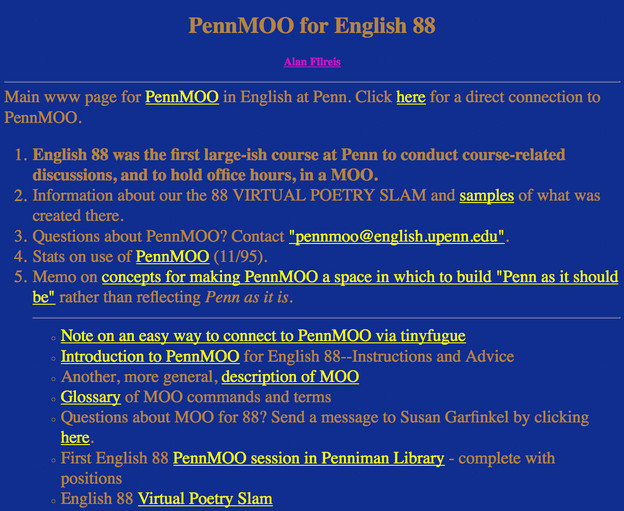MOO-based pedagogical idealism circa 1995
Click 'here' and be a poet

Don’t you love the look of web pages circa 1995? I made this page, as I made all my thousands of pages from the moment Mosaic showed me the possibilities of the graphical web browser; before that, I was much enamored of the Gopher, and built an elaborate Gopher for my poetry course (English 88) and for Penn's English department, where I happened to be in the middle of a long stint as undergraduate chairperson.
Once graphical interfaces with the world wide web were semi-stable, I moved English 88 into html files (coding them myself, of course). Next year, English 88 on the web will be 20 years old but I'll feel 10 years younger than I felt just before I first realized I could share this course with anyone, anywhere, without charge.
By 1995, thanks to the late Jack Abercrombie and Susan Garfinkel, students in English 88 (virtual members and of course students enrolled in the class at Penn) could meet in PennMOO, a non-graphical/text-only synchronous chat space where, with a little training, people would “do” things, “build” things, and make projects happen. I saw a natural opportunity here for a virtual poetry slam. We built a skating rink, and almost always did a few rounds of skating before groups of us entered various chat spaces to have separate conversations about the various poems we were studying. I built an office next to the skating rink for myself, and held virtual office hours — for anyone in the world — from 11 PM until midnight on Sunday nights each week.
The web page illustrated above is just one of many garish pages I made during the heyday of PennMOO for English 88. It's here. Probably most of the links are broken. PennMOO itself has been, sadly, shuttered for a few years. But, needless to say, the spirit of this innovative way of teaching and doing poetry lives on. My favorite overstated phrase on this page: “Penn as it should be.” And the phrase is hyperlinked, of course. “Go here,” as we used to say, and still do, and that's where you'll find an ideal.
Below is the text of notes I made in January 1996, a modest manifesto I suppose, called “Concepts for PennMOO.” I would like to point out that this was almost exactly the time I was creating the Writers House; the main founding principle of that project was and is articulated in this utopian statement about virtual learning spaces — an insistence on the end to the separation of the academic and social functions of and at the university. So here's that old note:
Not long ago, I described in general terms my own sense of what “structural” (that is to say, of course — CONCEPTUAL) changes PennMOO might undergo, if we wish it to serve as an ideal teaching space (rather than a reflection of the real). I’d like to say that point again — briefly — as a kind of call for proposals from among this group for ways in which the architecture can/ought to be changed to suit what I see as the needs of new forms of undergraduate teaching coming into being at Penn.
In order for virtual classroom/space interaction to be a part of the discussions about “21st Century Undergraduate Education” — and, not to put too fine a point on it, to be eligible for attention and even funding dollars that will be paid to innovative projects that harmonize with the goals of this large effort — we ought to adjust PennMOO so that it serves explicitly as the ideal space, as a currently unrealizable kind of space in the physical realm of Penn. PennMOO ought to strike those who enter it as not fundamentally resembling “Penn as it is” - rather it should present possibilities (various ones, to be sure) for “Penn as it should be” or “Penn is it could be.”
I would like this memo to serve as the beginning of a discussion that has as its objective a plan for how PennMOO should look and feel in the near future.
Who will start? What deadline should we set for ourselves?
My English 103, a course about the literature of community, will be making an effort to use PennMOO as a means of experimenting with ideal intellectual communities. So of course I'd like to have at least a section of MOO created with this notion in mind.
Some other points:
1. We should look for ways to make PennMOO interesting to graduate students and faculty, e.g. invite speakers who would not be otherwise available in person, and/or to start topic-based seminars that include graduate students from other schools.
2. We should work more energetically with faculty to move beyond the 'getting started' mode toward using PennMOO in more sophisticated ways.
3. We should explore partnerships with residences - particularly College Houses - so that virtual communities are part of the PennMOO landscape and so we are ready for the advent of full-scale residential “Colleges,” the first of which are to be opened in 9/97.
4. We should work to create a MOO-based community, overlapping with BUT DISTINCT from the course-based communities that inhabit the space at present. To this end, I'm going to suggest that we rethink the issue of students building their own spaces, and give 'unofficial' spaces a real chance to develop. I'm going to experiment with this in my English 103.
5. Create more spaces that “do” things, such as the poetry slam equipment and skating rink.
6. Generally, we should work to ELIMINATE THE SEPARATION OF ACADEMIC AND SOCIAL — we should integrate these as wholly and assiduously as we can. This is, after all, the one thing PennMOO can do that most other academic spaces literally cannot (with the exception of the very rare course taught in the students' residences).